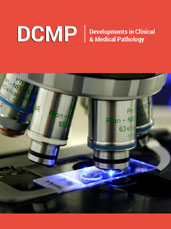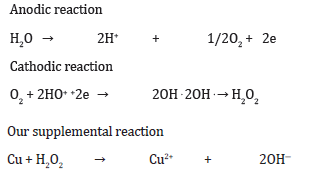- Submissions

Full Text
Developments in Clinical & Medical Pathology
Strong & Durable Sterilization by Improved Photocatalyst
Toru Kitamura*
Faculty of Science, University of Brunei, Brunei
*Corresponding author: Toru Kitamura, Faculty of Science, University of Brunei, Doctor of Engineering Toru Kitamura, Brunei
Submission: October 28, 2022;Published: November 30, 2022

ISSN:2690-9731 Volume2 Issue2
Introduction
Photocatalytic reaction has turned out to be to show and benign for practical sterilization purposes. Main reason is the unexpectedly low density of active oxygen arose from this reaction under the natural environment. Therefore, some supplemental measures must be taken to make this reaction practical for the public hygiene or healthcare. We adopted metallic fine copper powder as the supplemental ingredient with perfectly sufficient results so far (Figure 1). Thus, together with Nafion resin we have successfully invented new photocatalytic coating (Hereafter referred to “NFE2”).
Figure 1:

Theory & Outline
We have chosen copper ion Cu2+ to attain strong sterilization function in place of active oxygen such as hydrogen peroxide H2O2 and for this durable supply source adopted fine copper Cu powder. Fundamental reaction of the photocatalyst TiO2

Generated oxygen peroxide then reacts with metallic powder Cu thus arise strong Cu2+ slowly into the Nafion made photocatalytic layer. Copper ion concentration in the layer will become high enough in the cause of photocatalytic reaction to eradicate all kind of microorganism while only non-hazardous small amount will be dispersed in the environment thanks to the cation exchange nature of Nafion adopted as the binder of this coating. Only intermittent irradiation is necessary for this function to continue as copper ion Cu2+ will accumulate without any major consumption in the ordinary circumstance. Cross Sectional Structure of this photocatalytic coating layer.
Case study 1 mold control
Coated surface shows strong mold control function against Penicillium, Cladosporium and even Trychophyton fungus. As already mentioned, it can be detected immediately and with persistence unlike any conventional photocatalytic coating (Figure 2).
Figure 2:

Case study 2 mold control
This effect can be expected from the beginning as copper ion Cu2+ has long been applied just for this purpose. But superb water resistance is derived from the peculiar nature of Dupont made fluoropolymer Nafion, with has been otherwise widely adopted currently as the solid electrolyte of fuel cells (Figure 3).
Figure 3:

Case study 3 mold control
We have tested this NFE2 coated surface against various viruses including flu and norovirus. The latter is a notoriously resilient non-envelope type but disappeared within 1hour (Figure 4). We have already confirmed its effectiveness against initial COVID-19 by the cooperation of Nara Medical College, of which result shows the inactivation of this virus within 15min.
Figure 4:

Case study 4 mold control
In the improving process of this coating, we can fortunately accept the cooperation of University of Tokyo team to clarify the effectiveness against Omicron variant. We adopted this time WO3 in place of TiO2 to dramatically improve the activity under weak or dim irradiation, which should be necessary for the application to medical facilities in general. The result was quite satisfactory.
© 2022 Toru Kitamura. This is an open access article distributed under the terms of the Creative Commons Attribution License , which permits unrestricted use, distribution, and build upon your work non-commercially.
 a Creative Commons Attribution 4.0 International License. Based on a work at www.crimsonpublishers.com.
Best viewed in
a Creative Commons Attribution 4.0 International License. Based on a work at www.crimsonpublishers.com.
Best viewed in 







.jpg)






























 Editorial Board Registrations
Editorial Board Registrations Submit your Article
Submit your Article Refer a Friend
Refer a Friend Advertise With Us
Advertise With Us
.jpg)






.jpg)














.bmp)
.jpg)
.png)
.jpg)










.jpg)






.png)

.png)



.png)






